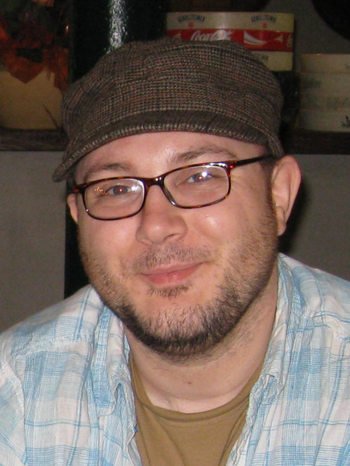Dr. Stefan Schreiber

Material Cultures and Object Studies (MaCOS)
Prähistorische Archäologie
Leibniz-Forschungsinstitut für Archäologie
Ernst-Ludwig-PLatz 2
55116 Mainz
Ausbildung
2013
Magisterabschluss des Studiums Ur- und Frühgeschichte,
Nebenfächer: Mittelalterliche Geschichte, Ältere deutsche Literatur und Sprache an der Humboldt-Universität zu Berlin,
Magisterarbeit: "'Kulturelle Aneignungen' als Strategien des Umgangs mit Dingen. Archäologische Betrachtungen zu einem kulturanthropologischen Modell"
Berufliche Tätigkeiten
2009 – 2012
Studentische Hilfskraft am Deutschen Archäologischen Institut, Zentrale Berlin, Exzellencecluster Topoi, CSG-V "Space and Collective Identities"
2009 – 2010
Studentische Hilfskraft am Institut für Archäologie – Ägyptologie und Archäologie Nordostafrikas, HU Berlin
Engagement
Seit 2011
Mitglied im wissenschaftlichen Beirat der Arbeitsgemeinschaft "Theorien in der Archäologie" e.V. (AG TidA)
Seit 2011
Mitglied im Forum Archäologie in Gesellschaft (FAiG)
Seit 2009
Mitglied in der Arbeitsgemeinschaft "Spätantike und Frühmittelalter" (AGSFM)
2007 – 2013
Mitglied im Vorstand des "Fördervereins für Ur- und Frühgeschichte an der Humboldt-Universität zu Berlin"
Travelling Things: Thinking on the character of ‘Roman imports’ in Central Germany’s ‘Barbaricum’
The aim of this study was to investigate the character of the “Roman import” phenomenon. In the past, “Roman imports” were usually discussed as objects in anthropocentric conceptualized contexts like trade contacts, mercenary services, gift exchanges, predatory economies and ethnic identities. In his dissertation project, by contrast, Schreiber offers a thinking perspective, that ‘Roman import’ should not be seen merely as a scientific construction, or an empirical category. Instead, he takes a symmetrical point of view. From a theoretical neo-materialistic perspective, Schreiber argues that things are not objects but assemblages (cf. DeLanda). They are heterogeneous and fluid entities. Therefore, to analyze things means to analyze not their stable essences but their intra-active enactments (cf. Barad) and entanglements.
Methodology
Stefan Schreiber’s methodology starts with source criticism and works without using the traditional taphonomic filter model. Instead, he benefits from the model of circulating reference by Latour, because both archaeological sources and already published sources are enactments from the archaeological record, just at different levels. This also allows to profit from ‘find catalogs’ like ‘Corpus of Roman Finds in European Barbaricum’ (Corpus der römischen Funde im europäischen Barbaricum/CRFB). For the analysis, the area of Saxony-Anhalt in Germany was chosen, mainly because of the up-to-dateness of the CRFB for this area. Additionally, it can be presumed, that there exists a plurality of enactments like cemeteries, so called princely graves, settlements, a rich tradition of archaeological inquiry and active federal heritage preservation.
To analyze intra-active enactments of already published ‘Roman imports’, Schreiber’s approach is based on the grounded theory from sociological qualitative research. He describes and interprets the following concrete enactments of and with finds: manufacturing traces, use traces, reuses and appropriations, adhering remains and impressions, burn marks, intentional damage, repairs and additions, recycling, hybrid forms and combinations, similarities and associations, as well as archaeological assemblages. These concrete enactments are then thickened to intra-actions: agential cuts, entanglements, mediations and translations, de/materialization and de/stabilization.
Results
From the identified and tested intra-actions, Stefan Schreiber develops the figure of the “Wanderin”, which literally means wayfarer or wanderer, but in this context actually also a traveler. This epistemological figuration is formed by his results of the analysis of ‘Roman imports’ and by the open metaphoric sense of travelling and wayfaring. It has the following extensible aspects: (1) the “Wanderin” hikes through spaces, (2) the “Wanderin” creates routes, (3) the “Wanderin” is dwelling from time to time, (4) the “Wanderin” moves rhizomatically, (5) the “Wanderin” can be invisible, (6) the “Wanderin” does not always travel autonomously, (7) the “Wanderin” is a transformer, (8) the “Wanderin” is an individual, (9) the “Wanderin” is a social entity, (10) sometimes the “Wanderin” can be known or unknown, (11) the “Wanderin” addresses boundaries and borders, (12) the “Wanderin” is a matter of concern and (13) the “Wanderin” is always a translator. All these aspects one encounters in the character of the ‘Roman import’ phenomenon. Thus, the “Wanderin” as an open figure helps to describe it, but the figure is also useful to recognize the character of other travelling things. It is a compatible figuration to analyze different things in motion, and works not only for ‘Roman imports’.
This dissertation project was successfully completed within the Research Group B-4 Space - identity - locality. The construction of knowledge related identity spaces of the Excellence Cluster 264 Topoi.
